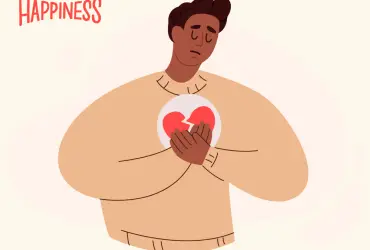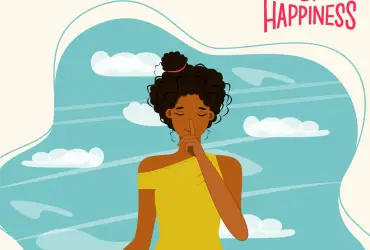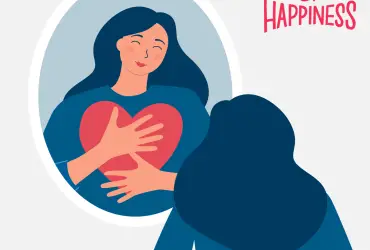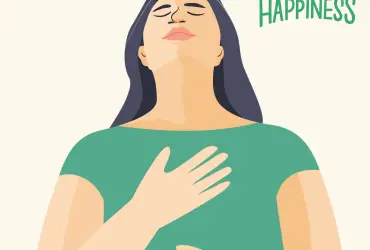Scroll down for a transcription of this episode.
Happiness Break: Visualizing Your Purpose, with Dacher
Finding a greater sense of purpose can help us achieve our goals and strengthen our relationships. Dacher leads a meditation to find purpose by imagining a better world.
How to Do This Practice:
Today’s Happiness Break host:
Find a comfortable place to do this practice. Once you feel ready, relax your shoulders and close your eyes. Focus on your breathing, and take a few slow, deep breaths.
Think about the world around you. If you could change one thing in society, what would it be?
Imagine this ideal world. Visualize it manifesting before you. Notice what you see and how you feel in as much detail as possible.
Is there anything that you can do to make this a reality? It can be anything, no matter how small. Think of some manageable steps you can take to get a little closer to what you’ve imagined.
Return your focus to your breathing to close out this practice.
If you have the time, jot down your thoughts and goals.
Dacher Keltner is the host of the Greater Good Science Center’s award-winning podcast, The Science of Happiness and is a co-instructor of the GGSC’s popular online course of the same name. He’s also the founding director of the Greater Good Science Center and a professor of psychology at the University of California, Berkeley.
Check out Dacher’s most recent book, Awe: The New Science of Everyday Wonder and How It Can Transform Your Life: https://tinyurl.com/4j4hcvyt
Find the full practice at our Greater Good in Action website:
https://ggia.berkeley.edu/practice/magic_wand
More resources from The Greater Good Science Center:
How to Find Purpose in Your Life: https://tinyurl.com/yc4dd5ff
Living with Purpose Changes Everything: https://tinyurl.com/m28uvsjn
The Purpose Challenge: https://tinyurl.com/53zykj8a
How Strong is Your Sense of Purpose in Life? https://tinyurl.com/2r3yr3hr
Purpose in Life Quiz: https://tinyurl.com/mrxys77h
We love hearing from you! Tell us about your experience of finding purpose. Email us at happinesspod@berkeley.edu or use the hashtag #happinesspod.
Find us on Apple Podcasts: https://tinyurl.com/2p9h5aap
Help us share Happiness Break! Leave us a 5-star review and copy and share this link: https://tinyurl.com/2p9h5aap
We’re living through a mental health crisis. Between the stress, anxiety, depression, loneliness, burnout — we all could use a break to feel better. That’s where Happiness Break comes in. In each biweekly podcast episode, instructors guide you through research-backed practices and meditations that you can do in real-time. These relaxing and uplifting practices have been shown in a lab to help you cultivate calm, compassion, connection, mindfulness, and more — what the latest science says will directly support your well-being. All in less than ten minutes. A little break in your day.
Transcript:
Dacher Keltner I’m Dacher Keltner. This is Happiness Break, a series by The Science of Happiness where we share short guided practices to help us develop more calm, kindness, connection and resilience to stress.
Today’s Happiness Break is an invitation to find purpose by imagining a better world. Together we’re going to conjure up goals aimed at improving society.
By thinking about our greater sense of purpose, studies show we create stronger social connections and are more satisfied in our romantic relationships. We also tend to be more physically active and sleep better.
Purpose is powerful.
So let’s start by exploring purpose by considering the world around us. And visualizing how it can be better.
I recommend grabbing a pen and paper to jot down some of your reflections afterward. It’s always good to write about our experiences with these practices.
When you’re ready, let’s begin.
So let’s get into a deepened pattern of breathing. Let’s find a nice posture, whether you’re sitting or lying down or standing. And relax your shoulders. Relax your body. And close your eyes. And just notice how you feel.
Let’s take a nice, deep breath in. Expanding your rib cage and your chest, counting to four. As you breathe out, follow the air through your lungs, your throat, and your nose counting to four. Another nice deep breath in, expanding your belly and your chest, filling your lungs full of air. And as you breathe out just notice the relaxation settling in, in your face, in your shoulders, and in your neck.
One more breath in. And breathing out.
Now, think about the world you live in. This includes your home, your community of friends, your family, your work colleagues. Bring some images to mind.
Now expand that to your neighborhood, your nation, your continent. And now try and think of the world at large. All eight billion of us plus the billions and billions of trees, plants, wildlife, insects, flora and fauna and animals.
Now imagine you can change anything in the world. Bring into your mind’s eye a desire that you deeply long for in society.
What would you want to be different? Why?
Very likely you have many of these things you want to change. But just rest your mind on one right now.
Notice the thoughts and emotions surrounding this desire. Not judging, simply noticing, and breathing.
Now imagine what this ideal world looks like.
For me, in this moment, what came to mind was we wouldn’t have the kinds of prisons that we have in the United States. And we would have public transportation that worked like the public transportation of Japan or parts of Europe.
Now, visualize this ideal world manifesting before your eyes, in the real world.
And now ask yourself, “What’s something that needs to change to get the world closer to this ideal vision?”
What can you do to help move the world closer to this ideal?
It could be something small to start—a conversation, a lifestyle change, a beach cleanup, taking public transportation.
What can you do to serve this greater purpose that you envision?
Imagine yourself doing one of the things you came up with. Really picture it.
Where are you when you do this? Who are you with?
Conjure that image in your mind with as much detail as you can. And just notice how it feels.
Where are you when you do this? Who are you with?
As we move towards closing this practice, let’s take a few more deep breaths.
Breathing in, and breathing out. Another nice belly expanding breath in. And breathing out.
Now just check in with your body and the contents of your mind. Maybe you notice a different feeling from when we began. Just notice what’s going on in your mind or in your body.
Maybe words or images or sensations that are arising because of this practice.
Now if you’ve got that pen and paper handy, jot down some of your thoughts. Maybe make a plan, something you can do to achieve this purpose. This greater goal.
Research shows that visualization is a powerful technique that helps us achieve our goals, and reduce anxiety.
I’m Dacher Keltner, thank you for taking this Happiness Break with us, to visualize a better world, and how we can purposefully be a part of solutions.
Happiness Break is a series by The Science of Happiness and a production of PRX and UC Berkeley’s Greater Good Science Center.










Comments